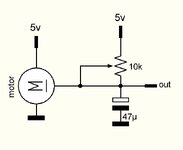neazoi
Advanced Member level 6
Hi, I have this little circuit. This uses a 3-pin computer fan, which shorts one of the motor pins to ground by the internal hal sensor.
After shorting, the capacitor is discharged and when the sensor is off again, the resistor charges the capacitor up to a point.
The problem is that these motors short (pulse) twice per revolution. I need a circuit that prohibits the second short per revolution, but not the first.
Then the cycle repeats again. Allow the fist pulse but prohibit the second on the next revolution and so on.
*It can be the other way round i.e. inhibit the first pulse and allow the second. I do not mind, as long as there is one pulse per revolution.
Is there any simple (I prefer discrete components, unless circuit is very big) circuit that can do this?
After shorting, the capacitor is discharged and when the sensor is off again, the resistor charges the capacitor up to a point.
The problem is that these motors short (pulse) twice per revolution. I need a circuit that prohibits the second short per revolution, but not the first.
Then the cycle repeats again. Allow the fist pulse but prohibit the second on the next revolution and so on.
*It can be the other way round i.e. inhibit the first pulse and allow the second. I do not mind, as long as there is one pulse per revolution.
Is there any simple (I prefer discrete components, unless circuit is very big) circuit that can do this?
Attachments
Last edited:
